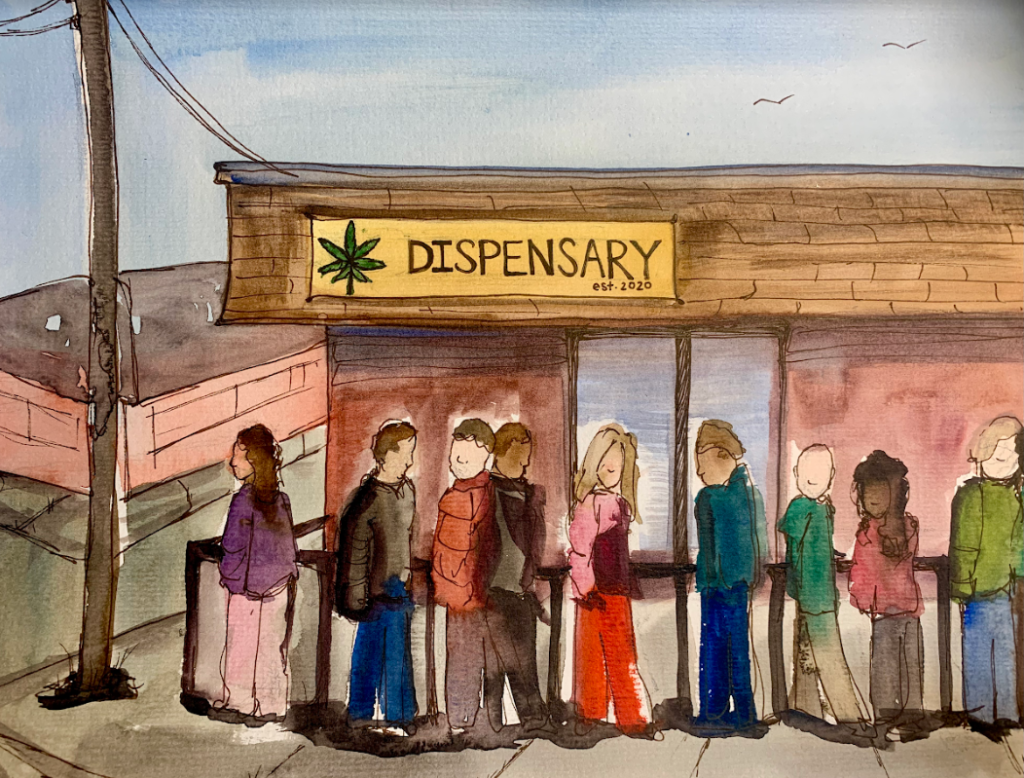On July 1, 2021 it became legal to possess up to 1.5 ounces of cannabis in the state of Connecticut — now sales at authorized outlets have begun.
The word “cannabis” refers to all products retrieved from the plant Cannabis sativa. The plant has around 540 chemical constituents, and one of its products is “marijuana,” which contains significant concentrations of cannabinoid tetrahydrocannabinol. THC is responsible for creating drug-inducing effects; however, some plants contain lower concentrations of THC and are used for industrial and medicinal purposes instead. There are over 100 types of cannabinoids, including cannabidiol, or CBD, which has much milder effects compared to THC and has anti-epileptic and neuroprotective attributes.
Cannabis can be used in different ways and the effects differ according to the form in which it is consumed. The most common form is smoking using the dried leaves and buds of Cannabis sativa. Another form is hashish, which is a dried plant compound, typically consumed by smoking with tobacco or by adding to foodstuffs. Hash oils and concentrates are liquids and extracts of the plant respectively. The former is smoked and the latter is vaporized in conservative quantities due to high THC concentrations.
“The plant makes chemicals to help itself to survive, not to make people stoned,” Godfrey Pearlson, professor of psychiatry and neuroscience at the School of Medicine and
Director of the Olin Neuropsychiatry Research Center, said. “Cannabis has been cultivated for thousands of years … to make strong fiber for ropes and sails, serve as a food and a medicinal plant, and… for intoxication and religious use.”
THC achieves its brain-altering, recreational functions through endogenous cannabinoids that act as neurotransmitters to enable communication between nerve cells. This allows THC to bind to cannabinoid receptors that may affect physical or mental behaviors. For instance, THC can affect how the hippocampus and the orbitofrontal cortex function in the brain, which are both regions associated with memory formation and attentional instincts.
Furthermore, it can impact spatial recognition, balance, posture and coordination by disrupting functions of the basal ganglia and the cerebellum. Therefore, it could be unsafe to drive or pursue physical activities under the influence of THC.
THC also achieves its addictive functions by stimulating the reward mechanism in the endocannabinoid system, or ECS, which activates during pleasurable activities such as sex and eating. Like most drugs, misusing cannabis will cause neurons in the rewards system to elevate levels of dopamine, which trains the brain to repeat the pleasurable behavior, making cannabis products highly addictive in nature.
“THC stimulation of CB1 receptors is responsible for most of the cognitive and behavioral effects that we associate with cannabis ingestion including euphoria, appetite stimulation, anti-nausea effects, sedation, anti-anxiety effects and drowsiness,” John Krystal, professor of translational research and chair of psychiatry, wrote in an email to the News. “But THC also produces anxiety, worsened concentration, impaired learning and memory, paranoia, racing thoughts, altered perception, sense of unreality and impaired coordination.”
Cannabis has been shown to have healing properties. Several unusual forms of epilepsy caused by chemotherapy, as well as decreased appetite caused by HIV/AIDS, may be helped by cannabinoid-containing medications. Moreover, some research points to minor benefits of cannabis for symptoms of multiple sclerosis. Alternative means of pain-relief could be opiates, which are highly sedating, or nonsteroidal anti-inflammatory drugs (NSAIDs) that cause reasonable threat to kidney patients.
The medicinal properties of cannabis are acquired through CBD and low quantities of THC. Various proposed modes of action for CBD have been studied, including interactions with GABA receptors, effects on serotoninergic and NMDA receptors, amplification of adenosine transmission and modulation of the flow of calcium ions. The additive benefits of CBD and THC, as well as CBD’s capacity to lessen the euphoric side effects of THC, may be attributed to pathways of CBD’s action.
The latest research in the field clarifies the beneficial effects of THC on epileptic management in animal models as well as the importance of the ECS in the maintenance of seizures. Moreover, CBD has also proven to be an anticonvulsant in animals undergoing epileptic episodes and can offset the effects of seizures by acting with THC in a synergetic fashion.
“Despite the growing trend of legalizing recreational cannabis use and medical use in the United States, the safety, potential health risks and long-term effects remain largely unknown,” Ke Xu, associate professor of psychiatry at the School of Medicine, said. “The mechanisms of …medical cannabis are still not fully understood.”
On Jan. 10, New Haven’s only adult-use cannabis retailer started dispensing cannabis solely for medical use.
H/T: yaledailynews.com



